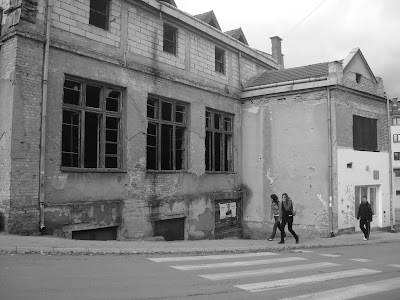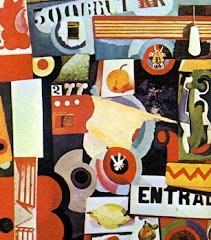





Derventa, Bósnia
Outubro 2009




NORTHERN Ireland is already world famous for the political murals that cover the gable walls of buildings and it appears a celebrated graffiti artist wants a piece of the action.
Over the past few days the people of west Belfast may have noticed some unusual black and white images stencilled...
Mercedes Sosa, an Argentine singer who emerged as a electrifying voice of conscience throughout Latin America for songs that championed social justice in the face of government repression, died today at a medical clinic in Buenos Aires. She was 74 and had liver, kidney and heart ailments.
With a rich contralto voice, Ms. Sosa was foremost a compelling singer whose career spanned five decades. She performed with entertainers as varied as rock star Sting, the Cuban singer-songwriter Pablo Milanés and folk singer Joan Baez, who said she was so moved by Ms. Sosa's "tremendous charisma" and emotive firepower that she once dropped to her knees and kissed Ms. Sosa's feet.
Ms. Sosa's towering artistry, which led to several Latin Grammy Awards, belied her physical dimensions. Short, round, dark-skinned and often dressed in peasant clothing, Ms. Sosa was affectionately nicknamed "La Negra" (the Black One) as an homage to her indigenous ancestry.
It was a term of endearment that followed her throughout the Spanish-speaking world, said ethnomusicologist Jonathan Ritter, who has written about Ms. Sosa. "It's hard to overestimate her popularity and importance as a standard-bearer of folk music and political engagement through folk music," he said.
Ms. Sosa once declared that "artists are not political leaders. The only power they have is to draw people into the theater." While not defining herself as a political activist, Ms. Sosa asserted herself in the "nueva canción" musical movement of the 1960s and 1970s that blended traditional folk rhythms with politically charged lyrics about the poor and disenfranchised.
This "new song" movement, formed by singers, poets and songwriters with Marxist leanings, cast light on the struggle against government brutality and the plight of the downtrodden throughout the hemisphere. Ritter said, much of the nueva canción songs favored by Ms. Sosa "drew upon the rich heritage of Latin American poetry and literature to score their political messages." This, he said, gave it a far-more enduring fascination than protest songs in the United States during that period, whose "blunt, direct lyrics were part of their political efficacy, but also limited their long term poetic appeal."
Here are the lyrics of "We're Still Singing," which she sang accompanied by the large Andean drum called the bombo: "I was killed a thousand times. I disappeared a thousand times, and here I am, risen from the dead. . . . Here I am, out of the ruins the dictatorship left behind. We're still singing." Ms. Sosa came under official harassment and intimidation by the right-wing, nationalist junta that ruled Argentina from 1976 to 1983. The government was responsible for the deaths and disappearances of an estimated 30,000 real and perceived leftists, and Ms. Sosa transformed her sold-out concerts into rallies against the abuses of power.
Her songs were banned from Argentine radio and television, and she courted arrest by singing anthems of agrarian reform such as "When They Have the Land" at one performance in the university city of La Plata. Many in attendance were arrested by security forces, and Ms. Sosa was publicly humiliated by an officer who walked onstage and conducted a body search.
Ms. Sosa scheduled more concerts in the face of threats against her. They were subsequently canceled when anonymous bomb threats were called in. The military governor of Buenos Aires prohibited her from further performances. Unable to earn a living or speak out as an opponent of the regime, she moved in exile to Europe in 1979 and lived for three years in France and Spain.
She recalled this as a dark period for her artistically, and at times her voice failed. "It was a mental problem, a problem of morale," she told the New York Times. "It wasn't my throat, or anything physical. When you are in exile, you take your suitcase, but there are things that don't fit. There are things in your mind, like colors and smells and childhood attitudes, and there is also the pain and the death you saw. You shouldn't deny those things, because to do so can make you ill."
Ms. Sosa returned to Argentina shortly before the dictatorship crumbled, and she found that her popularity had risen to a dramatic new peak. At home, her concerts attracted tens of thousands of ticket buyers, and her albums sold hundreds of thousands of copies.
Abroad, she was a star attraction as well, and a political celebrity. She received a 10-minute standing ovation for a 1987 concert at Carnegie Hall and received ecstatic reviews when appearing in other major American cities, including Boston and Washington. She broadened her repertoire to include rock, pop and cabaret songs, always sung in her native language.
Esquire magazine noted, "Your Spanish may or may not be good, but Mercedes Sosa requires no translation. Hers is the song of all those who have overcome their fear of singing out."
Haydée Mercedes Sosa was born July 9, 1935, in San Miguel de Tucumán in rural northwestern Argentina. She was of mixed Indian and French ancestry, and her parents were day laborers.
She said the geography and culture of the area was also crucial to her development. It was desolate, with far greater influence from the indigenous culture of nearby Bolivia than distant, cosmopolitan Buenos Aires. She called it "an advantage for someone who wanted to be a folk singer," and at 15, she won a local radio station's amateur-hour contest.
In the late 1950s, she and her first husband, guitarist Manuel Oscar Matus, with whom she had a son, moved to Mendoza, a city at the foot of the Andes. There, they helped form the new-music movement that fused folk rhythms with the language and politics of the moment, and wrote an artistic manifesto as well. Her international touring career followed her appearance at an important folklore festival in Cosquín in 1965.
Not a songwriter, she was a keen interpreter of others' works. The Chilean writer Violeta Parra was responsible for Ms. Sosa's signature song, "Gracias a la Vida" (Thanks to Life), a number more nostalgic that political. Ms. Sosa collaborated on two acclaimed albums in the early 1970s with composer Ariel Ramírez on lyricist Félix Luna on the albums "Cantata Sudamericana" ( South American Cantata) and "Mujeres Argentinas" (Argentine Women).
She received a Latin Grammy Award for Best Folk Album in 2000 for Ramírez's "Misa Criolla," and again for "Acústico" in 2003 and "Corazón Libre" in 2006. She continued to win over younger audiences by incorporating the music of rock singer-songwriters such as Argentina's Charly García and Sting, whose song "They Dance Alone" paid tribute to the disappeared in Argentina.
